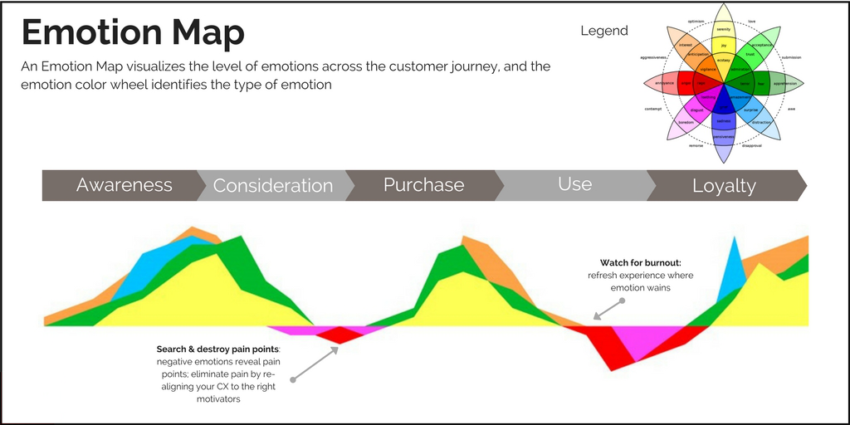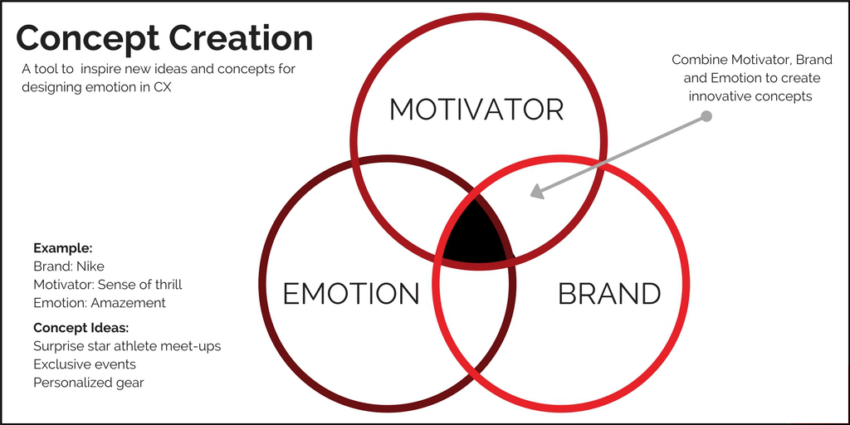POSTED : August 16, 2017
BY : Concentrix Catalyst
Categories: Customer Engagement

This is the third in our series on Emotion Design in CX. Check out the 1st, 2nd and 4th blogs in the series.
Emotion design strategy addresses the fundamental human motivation to avoid pain & seek pleasure. Here are two strategies, informed by the core principles of emotion, to design experiences that eliminate pain and drive joy among customers. These techniques enable businesses to increase customer connection by using emotion as a lever within CX.
Because negative emotions have more impact than positive ones, eliminating pain should be the first priority. These steps eliminate and mitigate negative experiences, to avoid loss of customer value.
Prioritize eliminating negative emotions
Assess your customer experience. Where are the pain points— moments where your customers struggle or express frustration? A good technique for this is emotion mapping, a map that tracks emotion levels across the customer journey. From this map you can visually identify pain where emotion levels dip below the line and are indicated in red. Prioritize the key pain points, and identify the negative emotions and underlying motivators associated with them. Then work to get rid of the negative emotions:

Utilize opposite emotions
While the former point is about getting rid of negativity, opposite emotions are about counteracting it. If a negative emotion occurs, customers are already unhappy. Neutralize the experience by driving the opposite emotion. The color wheel of emotion can help identify some complementary emotions, but this can also be done intuitively. For example, if a customer feels disgust, counter by building trust. If they feel sad, induce joy.
Watch for burnout
In addition to eliminating negative emotions, it’s important to watch for burnout. This is where emotion becomes neutral (at the baseline in the emotion map). It’s a signal that the experience is lacking value for the customer and at risk of becoming negative. While some drop-off in emotion is natural after a peak moment, persisting neutrality is a red flag. Overexposure or lack of engagement can cause positive emotion to weaken. Be aware of this and correct these intervals of “burnout” by refreshing the experience.
Driving joy is focused on tapping into customer motivators with positive emotions, driving emotional intensity over time, and capitalizing on key moments. Below are ways to identify and design for positive emotion.
Align motivators and emotions associated with your brand
The first step is to identify the motivators your customers seek and the corresponding positive emotions that your brand should evoke (ex. motivator: sense of belonging, emotion: acceptance). The Top 10 Emotional Motivators and the color wheel of emotion can be helpful guides to understand what motivators and emotions to look for. Prioritize the motivators and emotions that are most compelling for your brand. Identify where they show up in your customer experience to understand which moments drive these key emotions.

2. Design to innovate
Now that you’ve identified key motivators & emotions, use them to design new experiences.

Develop emotional intensity over time
It’s important to nurture emotional connection over time. Start small by engaging customers with low-intensity emotions and progress to high-intensity emotions. The wheel of emotion is a great resource to guide this process, working from the outside to the center of positive emotions. This strategy is especially true for new customers. Trying to tap into admiration upfront can be disingenuous, whereas a gradual approach to making customers feel accepted, then trusted and ultimately admired is more likely to yield success. Knowing the life cycle stage of your customers is important to provide the correct level of emotional intensity within your CX.
Define “wow” moments
To make the most of emotion design, don’t forget to emphasize the “wow” moments. These are moments that are most memorable for customers, typically at the peak and endpoints of an experience. Look for these moments in your customer experience. An emotion map can help to identify them. What makes them positive—ease of use? surprise? feeling special? Learn what works and replicate at other moments in the customer experience.
By focusing on emotion at key moments across the customer journey, organizations will be well-positioned to drive engagement & loyalty. Customers will recall positive associations with the brand and continue to engage in the future, building emotional connection over time.
For a holistic view on customer engagement strategy and how to apply it to your business, download The Ultimate Guide to Customer Engagement.
Tags: Customer Experience, CX, Emotion in CX, Emotion in CX Series